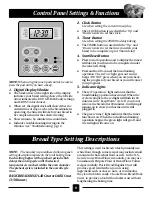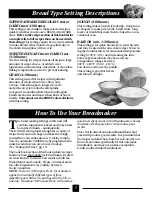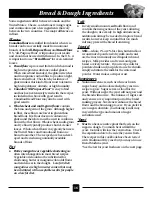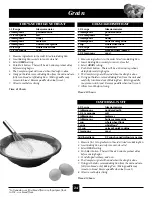
Some ingredients differ between Canada and the
United States. Cheese, confectioner’s (icing) sugar,
and cornmeal are just a few ingredients that vary
between the two countries. The major difference is
in flour.
Flours
Canadian flours
are milled from harder wheats so
breads can be successfully made from national
brands of both
All-Purpose Flour
and
Bread Flour
.
U.S. “All-Purpose Flour” will produce poor results
and should not be used with this unit. In the U.S., it
is important to use
“Bread Flour”
for even-textured
loaves.
●
Bread flour
is processed from hard wheat and is
high in the protein substance called gluten.
When mixed and kneaded, the gluten stretches
and incorporates air bubbles to produce a light,
fine-textured loaf. The stretchy resilience of
gluten makes this kind of flour most tolerant to
high temperatures, altitude, or high humidity.
●
Canadian “All-Purpose Flour”
is easy to find
and has been extensively tested with the recipes
included in this book with good results.
Canadian Bread Flour may also be used with
good results.
●
Whole wheat and multi-grain flours
contain
the bran and germ of the grain. Although higher
in fiber, these flours are lower in gluten than
bread flour. Rye flour does not contain any
gluten and therefore, must be used in combina-
tion with other flours. Whole wheat, multi-grain
and rye flour typically produce shorter, denser
loaves. Whole wheat flours vary greatly between
the United States and Canada and from one
brand to another. The recipes have been devel-
oped and tested using nationally available
brands of flour.
Fat
●
Butter, margarine or vegetable shortening
are
often interchangeable in most bread recipes.
Vegetable oil should not be substituted for
shortening, butter or margarine (fat adds flavor
and tenderness to the dough).
Low-fat (diet)
margarines are high in water content but may
be substituted with acceptable results for people
on a low fat diet.
Salt
●
In very small amounts,
salt
adds flavor and
controls the rising action of the yeast, allowing
the dough to rise evenly. In high altitude areas,
additional salt may be needed to improve bread
results, however, keep in mind that too much
salt may prevent the bread from rising.
Liquid
●
Milk
—whole, 1% or 2% fat, skim, buttermilk, or
reconstituted (powdered) dry milk, and water
are the most commonly used liquids in bread
recipes. Milk provides a soft crust, and gives
bread a velvety texture. If your recipe calls for
powdered milk and you prefer to use fresh milk,
simply substitute the milk for the water and
powder. Water makes a crisper crust.
Sweeteners
●
Natural sweeteners, such as white or brown
sugar, honey, and molasses help the yeast in a
recipe to grow. Sugar serves as food for the
yeast. Without sugar, the yeast will not grow and
the bread will not rise. The balance of sugar, salt,
and yeast is a very important part of the bread
making process. Sweeteners enhance the bread
flavor and the browning process. If you prefer to
use a sugar substitute, your baking results may
vary with the type and amount of sugar
substitute used.
Yeast
●
Yeast
is a heat-sensitive plant that feeds on the
sugar in dough. Too much heat will kill the
yeast, too little will slow the yeast action. Check
the expiration date to be sure the yeast is fresh.
The recipes in this cookbook have been tested
with Traditional Dry yeast but you may also use
Bread Machine yeast.
*See the test for yeast freshness on the next page.
16
Bread & Dough Ingredients
Содержание All-In-One Horizontal B2000
Страница 15: ...15 For Black Decker Breadmaker Model B2000 ...
















































